Fast growing upright deciduous shrubby perennial with silvery foliage and lush fall display of delicate blue flowers. Bees love it! Firewise.
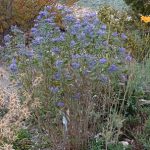
- Blue Mist Shrub
- 5
- Sun
- 3' x 3'
- Asia


Fast growing upright deciduous shrubby perennial with silvery foliage and lush fall display of delicate blue flowers. Bees love it! Firewise.
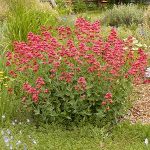
Jupiter’s Beard produces masses of crimson flowers fading to pink from late spring right through the summer. Periodic deadheading will enhance the bloom even more. Attracts Swallowtails and Monarchs. Can seed out somewhat aggressively. Firewise.
Easy, reliable.
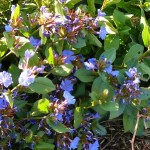
Valuable as a shade-tolerant groundcover, Plumbago will also grow in full sun. Glossy deep green leaves and lovely blue flowers with striking red calyces make this a most attractive spreading groundcover. The plant vanishes in winter, but comes back reliably each spring.
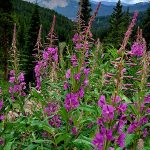
This beauty of the Idaho mountains can live in a garden, but may spread aggressively.
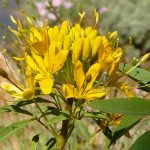
Yellow Bee Plant is a smaller cousin of the purple Rocky Mountain Bee plant, Both of these annuals are extremely valuable as food sources for native bees and butterflies as well as honeybees. Very long-blooming and freely reseeding in the garden. Available spring only.
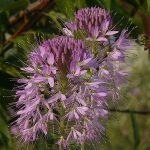
This outstanding native annual is a magnet for honey bees and native bees alike! Tall stalks end in multiple flowers that look as if they were designed by Dr. Seuss. Once it starts blooming in early to mid-summer, Rocky Mountain Bee Plant just keeps going until fall. More information here.
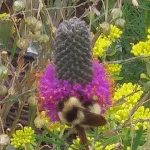
Purple Prairie Clover produces lovely purple bottle-brushes on erect stems. Perfect specimen plant or as part of a meadow or prairie planting. Long-lived, with a deep taproot. Often found on eroded, depleted soils, including caliche. Supports bees and butterflies and fixes nitrogen.
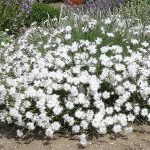
Sand Pink forms large hummocks packed with narrow evergreen foliage. In late spring it is covered with extremely fragrant little white flowers like snowflakes. Attracts butterflies. Firewise.
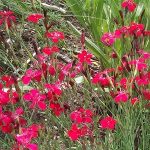
‘Flashing Lights’ Dianthus (Pink): This evergreen dianthus is not pink, but a deep, brilliant red. The mound of narrow, dark green, grassy leaves is attractive year-round. Great for low edging at the front edge of a bed or in a rock garden. Attracts butterflies. Firewise.
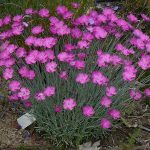
‘Firewitch’ Dianthus (Pink) is a bouquet of electric magenta flowers with frilly edges over a mound of attractive gray-green foliage. Excellent rock garden plant, or use at the front of a border. Attracts butterflies. Firewise.
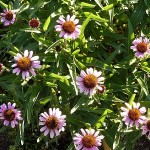
This tap-rooted perennial is found in open, dry prairies of the Midwest, and is prized for its medicinal value. It is also highly ornamental, with lovely purple coneflowers floating above narrow-leaved stalks. Good nectar plant for butterflies and bees.
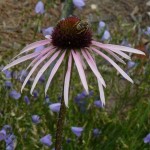
Thin purple petals of this Conflower drape delicately from a bold brown center. It is lovely in a bouquet and also great for naturalizing en masse in the garden. Its deep taproot allows it to thrive in dry soils. Nectar plant for Monarch and other butterflies. Tolerates clay. Pollinators: bees, butterflies.
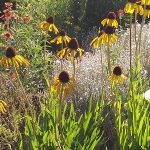
This is the only Coneflower with yellow rather than purple flowers. Its drooping yellow petals surround large, coppery-brown cones. Nectar plant for Monarch and other butterflies. Tolerates clay.
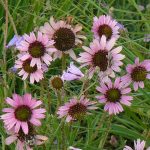
Shorter than other Echinaceas, Tennessee Coneflower cheerfully faces the rising sun and blooms like crazy–even despite heat and low water. Native to dry, rocky areas in Tennessee, it does well in the Intermountain West.
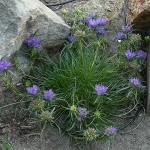
Grassy Bells, an ideal rock garden plant with small tufts of grassy leaves covered in bell-like flowers. The blossoms are violet-blue, on short, outspreading stems. Perfect for edging or containers.
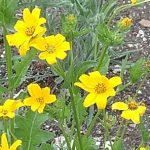
This cheerful wildflower blooms throughout summer, even in drought. Good pollinator plant.
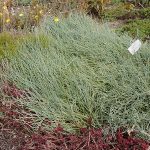
This is the prostrate form of the native Mormon Tea shrub. Thin stems intertwine on the ground to gradually form a thick, sprawling, evergreen groundcover. In mid-summer dozens of bright red berry-like flowers appear, nestled down in the foliage. From Tibet, rare.
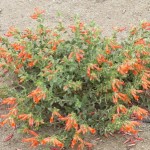
The red tubular flowers are a magnet for Hummers in the late summer and early autumn, as these tiny birds prepare for their annual migration. Adaptable to many soil types and low water, Hummingbird Trumpet provides a spectacular splash of color in the late season garden.
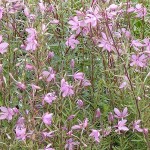
This is a miniature European version of our beautiful native Fireweed. We have been reluctant to offer Fireweed itself as it can be very invasive. Alpine Willowherb is much smaller and promises to be better behaved in the garden. Supports honeybees.
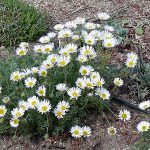
Cutleaf Daisy is a vigorous, long-blooming native Fleabane with dissected leaves and bundles of charming white flowers. Excellent for rock gardens or exposed slopes with good drainage.
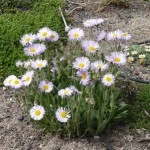
Beautiful Fleabane is a low-growing, early-blooming native daisy. Forms ever-widening patches over the years. Cheerful purple flowers attract pollinators.
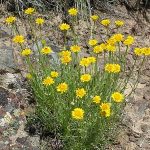
Desert Yellow Fleabane is a small native daisy with cheerful yellow flowers in summer. Grows in poor soil with little care.
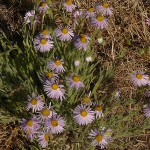
Cheerful little Shaggy Fleabane (Shaggy Daisy) is native to the Boise Foothills. It will survive without additional water, but will flower much more vigorously if given a bit of extra moisture.
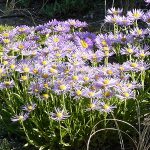
Showy Fleabane is an erect native Daisy (or Fleabane) with narrow leaves and cheerful purple that flowers in early to mid-summer. Usually occurs in woodland openings or edges. Attracts native bees and butterflies.
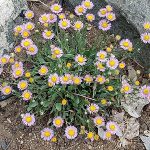
Tidy mounds of delicate lavender flowers with yellow centers. Choice rock garden or edging plant.
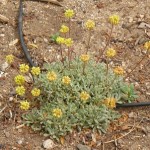
A beautiful mat-forming buckwheat topped with delicate round flowers–pale yellow, fading to pink or orange. Excellent rock garden plants. Supports native bees. Choice!
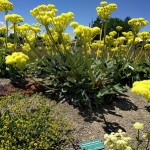
Arrow Leaf Buckwheat has big oval, pointed leaves basal leaves with leafless stems of cream to yellow pom-poms overhead. Thrives in hot, dry and poor soils. Unusually large buckwheat. More information here.
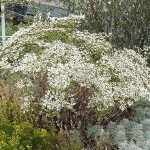
The largest of our Buckwheats, Lacy Buckwheat is an amazing fall bloomer. It forms large domes of finely divided woody branches that are covered with tiny white flowers Sep-Oct. Stunning! Supports honeybees and native bees. Prefers sandy/gravely soils and will tolerate poor soils. More information here.
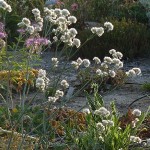
An amazingly statuesque Buckwheat! Add elegant structure to your xeric flower garden with this native beauty! Off-white flowers top the long stalks in mid-summer.
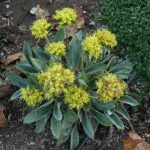
A compact high elevation Idaho buckwheat with narrow leaves and charming yellow flowers.
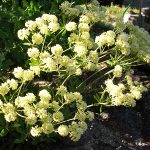
Whorled Buckwheat has leathery leaves which form a basal mat sending up brilliant white, cream color pom-poms in early summer. Likes well-drained soil. Boise foothills native. Pollinators: butterflies, bees.
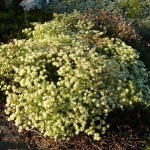
This Buckwheat forms large, dense mats covered with cream-colored to yellow flowers. It blooms during the heat of mid-summer when many other Buckwheats are done. Supports native bees.
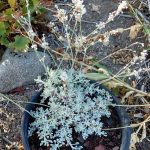
Dense, flat clusters of tiny, woolly, gray-green leaves sending up spikes of airy white flowers in late summer. This gorgeous little Buckwheat is native to the Sierra and Western Great Basin of California. Lovely in a rock garden.
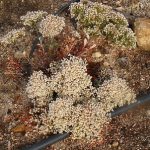
This small Idaho native is covered with hundreds of pinkish white flowers in late summer or early fall. Gorgeous rock garden plant.
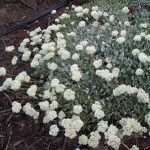
This Buckwheat features white pom-pom like flowers over expanding tuffets on tight gray-green leaves. Choice!
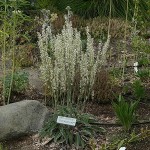
This striking buckwheat bears long racemes of white or white/pink flowers atop tall, leafless stems. In its native habitat of low foothills and mountain dry meadows from New Mexico to Nevada, it can grow in colonies of hundreds or thousands. Supports native bees.
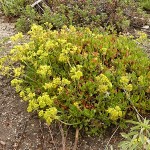
This beautiful little plant appears to be a variety of Sulfur Buckwheat. Its sculpted leaves and diminutive shrubby form make it an outstanding rock garden plant. Blooms earlier than our regular Sulfur Buckwheat.
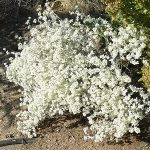
Strict Buckwheat has gorgeous sprays of pinkish-white flowers that glow in the late summer/early autumn garden. Supports native bees and is a late season nectar source for honeybees. Boise foothills native. More information here.
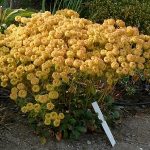
Sulfur Buckwheat is arguably the best all-around landscape plant native to S. Idaho. Bright yellow flower heads rise over a mat of spoon-shaped leaves and mature into a lovely copper color over the summer. The basal leaves turn reddish-green in the fall and are attractive all winter long. Boise foothills native. Pollinators: butterflies, bees. Firewise.
A dense carpet of gray-green leaves topped with a cloud of delicate pinkish-white blossoms. Rock gardens. Tolerates clay.